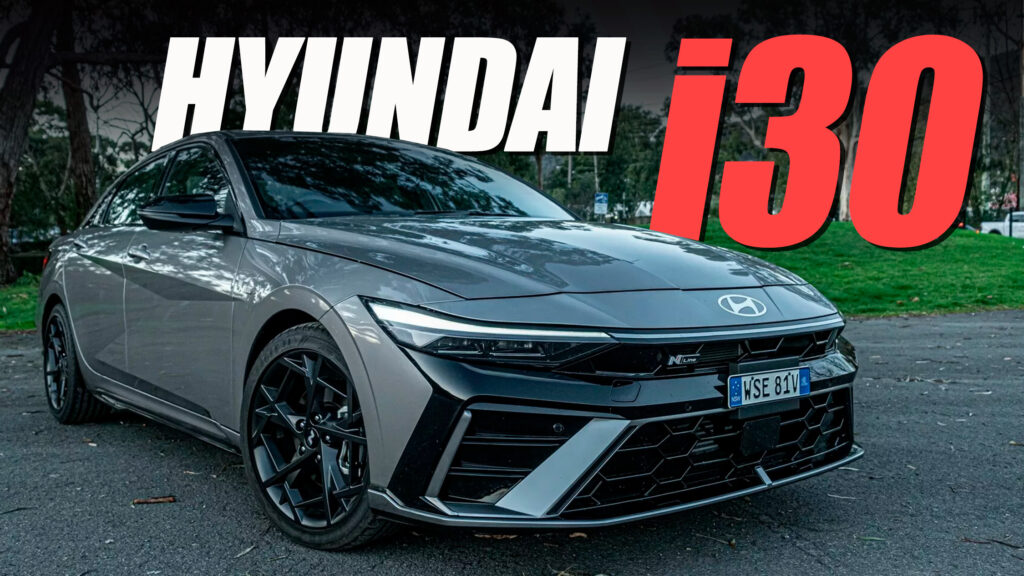2024 Hyundai i30 Sedan N Line Review: Value Meets Performance

An Affordable and Appealing Sedan
A decade ago in Australia, it was possible to walk into a Hyundai dealership and buy a brand-new Elantra for AU$20,000 (~$13,300). While those days are long gone, the facelifted 2024 i30 Sedan still represents good value for money and, in N Line guise, is particularly appealing.
Quick Facts
| Model: | 2024 Hyundai i30 Sedan N Line |
| Starting Price: | AU$36,000 Plus On-Road Costs |
| Dimensions: | 4,710 mm (185.4 in.) L x 1,825 mm (71.8 in.) W x 1,420 mm (55.9 in.) H, 2,720 mm (107 in) Wheelbase |
| Curb Weight: | 1,340 kg (2,954 lbs) |
| Powertrain: | 1.6-liter turbocharged four-cylinder |
| Output: | 150 kW (201 hp) and 265 Nm (195 lb-ft) |
| 0-62 mph: | ~7.5 seconds (0-100 km/h) |
| Transmission: | Seven-speed dual-clutch |
| Fuel economy: | 6.6 l/100 km (35.6 U.S. mpg) |
| On Sale: | Now |
An i30 for everyone
The updated i30 Sedan range starts at AU$29,000 (~$19,300) for the base model with the 2.0-liter naturally-aspirated four-cylinder or AU$33,000 (~$22,000) for the new 1.6-liter turbocharged hybrid. The range then grows with the i30 Sedan Elite priced from AU$33,500 (~$22,300) for the 2.0-liter, and AU$38,500 (~$25,600) for the i30 Sedan Premium. Sitting between these two models is the version we lived with, the AU$36,000 (~$24,000) i30 Sedan N Line.
Those willing to stretch their budget a little further will need to cough up AU$41,500 (~$27,600) for the i30 Sedan N Line Premium. That’s the flagship model of the standard range and only sits below the potent AU$52,000 (~$34,600) i30 Sedan N Premium, one of the finest hot sedans at its price point.
A Pleasant and Premium Cabin
Little has been done to the inside of the 2024 sedan, but that’s no bad thing. When I first drove the i30 Sedan a few years ago, I was impressed with the build quality and the fit and finish of the cabin, considering the car’s starting price. The same can be said of the current model.
The seats of the pre-facelift model have been carried through to the new one, offering good bolstering and are soft to the touch. However, the angle of the seat bases means they offer very little under-thigh support for tall drivers. Not even a square inch of my thighs were touching them when I was driving. I could only rest my thighs on the seats if I stretched out my legs behind the pedals, which isn’t safe.
Positioned ahead of the driver is a N-branded steering wheel wrapped in black leather with red contrast stitching and plenty of physical buttons and switches for the cruise control and media settings. There’s also a large digital instrument cluster.
As our test car was the entry-level N Line and not the N Line Premium, it made do with an 8.0-inch infotainment display as opposed to the 10.25-inch display of the higher-end version. This display offers Apple CarPlay and Android Auto support but runs an old version of the Korean brand’s software, voiding many features and settings of other Hyundai models. It’s one of the most basic infotainment systems we’ve used in recent years and was a disappointment.
A Comfortable Ride but an Unrefined Powertrain
Power comes courtesy of a 1.6-liter turbocharged four-cylinder. This engine is good for 150 kW (201 hp) at 6,000 rpm and 265 Nm (195 lb-ft) of torque between 1,500 rpm and 4,500 rpm, figures identical to the pre-facelift model. Coupled with this engine is a seven-speed dual-clutch automatic transmission driving the front wheels.
I was pleasantly surprised with how much punch the N Line provides. It has slightly more grunt than the 139 kW (186 hp) and 252 Nm (186 lb-ft) of the Mazda3 G25, and you can feel this extra poke, although the differences are only slight.
Unfortunately, the engine doesn’t sound as nice as the one in the Mazda. It makes quite an unpleasant racket at high revs. The car also experiences a lot of torque steer, which is strange given it doesn’t have that much power for a front-wheel-drive car. If you pin the throttle with the steering wheel turned even slightly, the latter will tug, and the inside tire will start to lose traction.
Fortunately, the i30 Sedan N Line is impressively frugal. Hyundai claims it sips 6.6 l/100 km (35.6 U.S. mpg) over the combined cycle and on long highway jaunts, that’s exactly what we averaged with 98 octane fuel. On the same roads, but filled with 95 octane fuel, consumption increased to 6.9 l/100 km (34 U.S. mpg). We also experimented with 91 octane fuel over the same highway roads and averaged 7.2 l/100 km (32.6 U.S. mpg).
Verdict
The closest rival to the i30 Sedan that we’ve driven in recent months is the Mazda3 Sedan. It starts at AU$32,990 (~$22,000) and tops out at AU$47,147 ($31,386), making it slightly more expensive than the Hyundai. The Mazda cabin feels nicer, but of the two, the i30 sedan is the more exciting to drive, particularly in N Line guise. Buyers would be wise to test out both to see which they prefer.

